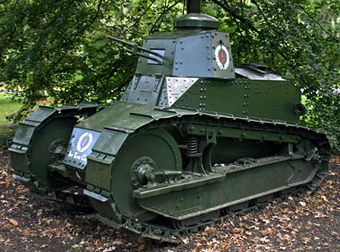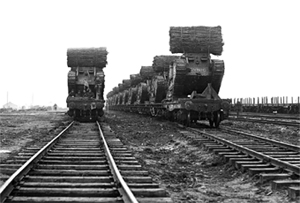
Photo courtesy of First Division Museum
Big Willie Comes of Age:
The Tank in Combat at Cambrai
| published December 20, 2015 |
By Kevin Robbie, Thursday Review contributor
Editor's Note: This is Part Two of a series about the development of the tank for battlefield purposes; Part One can be found here: The Anniversary of Big Willie: How the Tank Made it to Battle; Thursday Review.)
After two years of frantic development by Britain and France, the successor to Big Willie, the first workable prototype tank, was introduced into combat at Flers-Coucellette on September 16, 1916, during the Battle of the Somme.
The British Army brought thirty-two vehicles to the battlefield. Of that number, nine broke through the German lines. The British armor supporters saw this as validation that the tank was a viable battlefield asset. Their French counterparts, however, were more cautious in their assessments, concluding the British had employed the tanks prematurely because the design wasn't sufficiently mature. The French also believed the tanks were used in numbers too few to affect the course of the battle. They also noted that the tanks - after initially breaching German lines--were unable to maintain their breakthrough.
In fact, the French position was, initially, the more accurate. The tanks did not have a significant tactical impact on the battlefield at Flers-Coucellette. On one hand, the vehicles had demonstrated an ability to cross shell craters up to nine feet wide and plow through the ubiquitous barbed wire. Their armor would stop small arms rounds and small fragments from artillery. However, conditions inside the tanks were atrocious for the crews. Men were exposed to carbon monoxide fumes from the engine and cordite fumes from the expenditure of ammunition. Temperatures inside the crew compartment could rise to over 100 degrees. Crews were also exposed to fuel leaks, bone-jarring vibrations from the engine, and they endured a rough ride over the often uneven, pockmarked ground due to the primitive suspension, leading to a rapid physical exhaustion.
A year later, at the Battle of Cambrai in November, 1917, the tank's accomplishments brought it general acceptance. This battle was considered the first "combined arms" operation on a modern battlefield. The effects of armor, infantry and artillery were combined and coordinated to achieve a maximum simultaneous impact on the enemy. These operations were more finely crafted and developed in a subsequent war. Allied tanks penetrated the German front lines in numerous places but, again, they could not exploit their breakthroughs due largely to mechanical failures, crew exhaustion and command inadequacies. In other words, a new weapon with great potential had appeared on the battlefield even though no one had yet figured out how to effectively and consistently use it in a tactical context.
The French army had been working on developing a tank, too. They produced the Renault LT, for which some 3,000 were produced, making it the most numerous tank of the war. French designers experienced many of the same problems with their tanks as did the British. The Americans, due to their late entry into the conflict, relied on British and French machines, primarily the Renault LT. The first "American" tank was the M1917, a license-built near-copy of the Renault tank. Production did not begin until autumn of 1918, though, and completed vehicles did not reach France until hostilities had ended with the armistice of November 11th.

The first American tank unit was initially "1st Battalion, Heavy Tank Service." It was activated in March, 1918, and began training at Camp Meade, Maryland. One of the first officers assigned to the new unit was Captain Dwight Eisenhower, who was instrumental in the unit's development due to his organizational and administrative skills.
As for the Central Powers, the German's viewed the tank with disdain upon first seeing it employed by the Allies. From their perspective, the new vehicle was too clumsy for maneuvering around on the battlefield as an offensive weapon. They also believed the tank too vulnerable to infantry attack. The Germans also were cognizant of the numerous mechanical breakdowns of Allied vehicles. By the time of Cambrai, the Germans were primarily on the defensive, which also contributed to their early assessment of the tank as impractical for their use. The Germans produced their own prototype but they used a handful of captured Allied vehicles on a very limited basis. Only twenty German-made vehicles were used in battle during World War I. Before the next war, however, the Germans would change their minds about the tank's future.
Tanks were not a prominent weapon in World War I due to their primitive designs and inconsistent tactical employment. However, the early use of the tank on the Western Front and its progress at Cambrai, demonstrated its viability for the modern battlefield. Twenty years later, the tank would secure its place as an indispensable weapon of war.
Related Thursday Review articles:
The Anniversary of Big Willie: How the Tank Made it to Battle; Kevin Robbie; Thursday Review; September 30, 2015.
A Peaceful Little Glade: The First Armistice at Compiegne; Kevin Robbie; Thursday Review; November 10, 2015.
